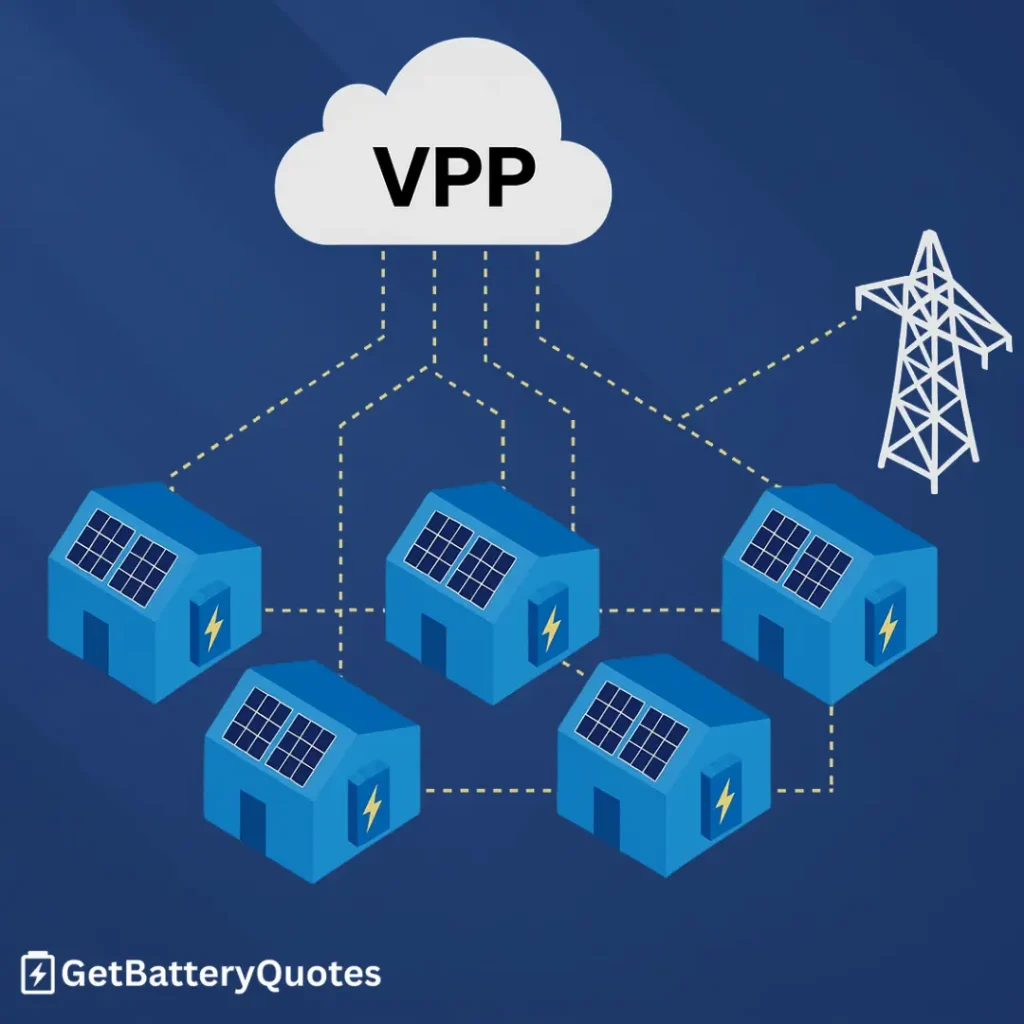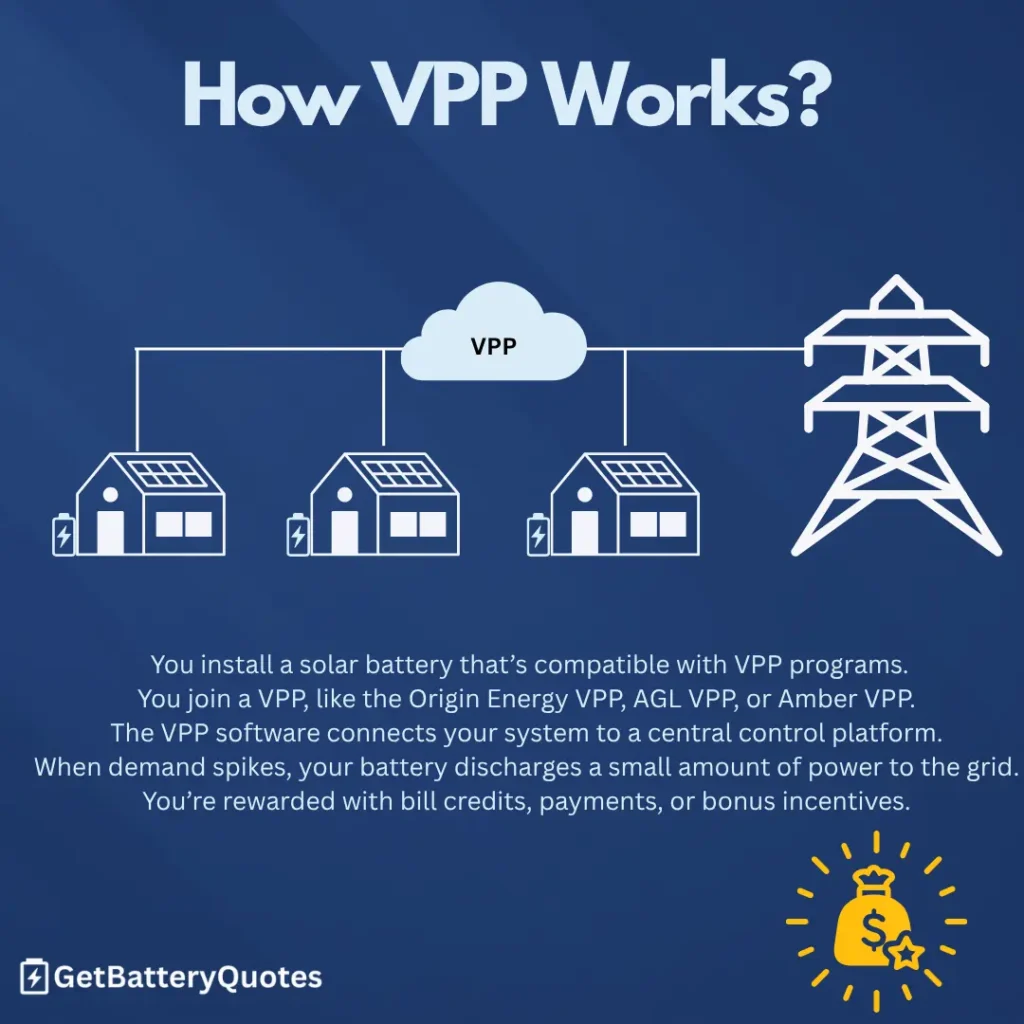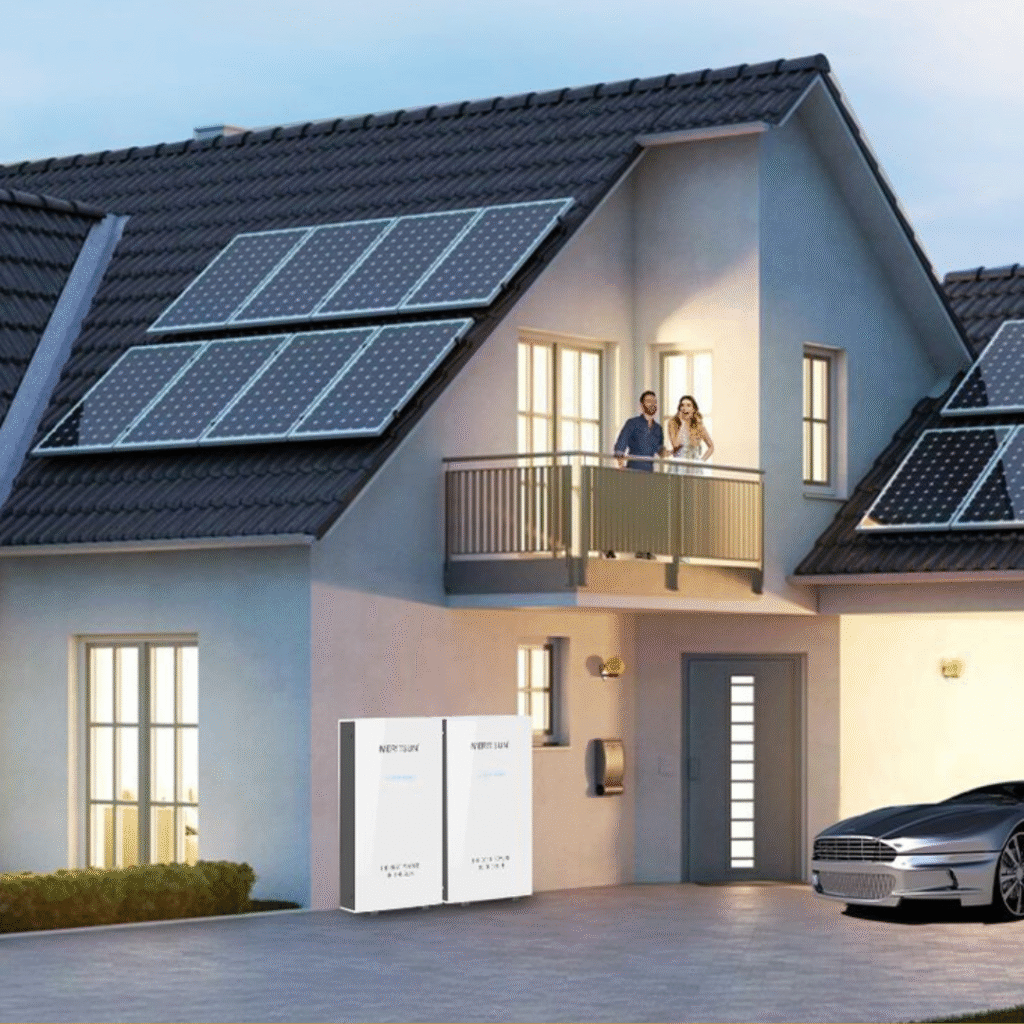Virtual Power Plant (VPP)
Table of Contents
- 1. What Is a Virtual Power Plant (VPP)?
- 2. How Does a Virtual Power Plant Work?
- 3. Why Join a VPP?
- 4. Things to Watch Out For
- 5. Quick Tip: Ask These Questions Before Joining a VPP
- 6. Popular VPP Programs in Australia
- 7. Are VPPs Safe and Reliable?
- 8. Do VPPs Affect My Battery Warranty?
- 9. How Much Can I Earn in a VPP?
- 10. Can I Still Access Blackout Protection?
- 11. How to Choose a VPP
- 12. How VPPs Fit With the Federal Battery Rebate
- 13. Final Verdict: Should You Join a VPP?
- 14. Summary
- 15. So, is a VPP worth it?
What Is a Virtual Power Plant (VPP)?
A VPP lets your solar battery team up with others to help the grid and earn you rewards.
- What is a VPP?
- What is a virtual power plant?
- Is a virtual power plant worth it?
You’re in the right place. This guide will break it all down in plain language so you can decide whether joining a VPP is right for your home.


How Does a Virtual Power Plant Work?
- 1. You install a solar battery that’s compatible with VPP programs.
- 2. You join a VPP, like the Origin Energy VPP, AGL VPP, or Amber VPP.
- 3. The VPP software connects your system to a central control platform.
- 4. When demand spikes, your battery discharges a small amount of power to the grid.
- 5. You’re rewarded with bill credits, payments, or bonus incentives.
- How does a VPP work?
- How does VPP works in real life?
The answer is simple: it’s a way to get more value from your solar battery while helping support Australia’s energy system.
Why Join a VPP?
Earn Extra Value from Your Battery
Improve Battery Payback Time
Support the Grid and Your Community
By sharing excess energy during peak times, you’re helping avoid blackouts, reduce the need for fossil fuels, and ease pressure on the national grid. This is especially important in high-demand areas like NSW, Victoria, and South Australia.
Get Access to Special Programs or Rebates
Things to Watch Out For
You Give Up Some Control
VPP Rewards Can Be Inconsistent
“What are the disadvantages of a virtual power plant?”
Not All Systems Are Compatible
Event Timing May Not Suit Everyone
Quick Tip: Ask These Questions Before Joining a VPP
- Will I still have enough battery left for my evening usage?
- How often do VPP events occur in my area?
- Can I opt out of VPP events if needed?
- Will this affect my backup power in a blackout?
Popular VPP Programs in Australia
AGL Virtual Power Plant (AGL VPP)
- Available in NSW, VIC, SA, and QLD
- Compatible with Tesla, SolarEdge, and more
- Offers up to $400 in sign-up bonuses or bill credits
- Supports blackout protection in some models
Origin Loop VPP
- Works with selected batteries including Tesla and LG
- Offers upfront credits plus ongoing bill savings
- Focused on homeowners with solar and battery systems
Tesla Virtual Power Plant (VPP South Australia)
- Built by Tesla in partnership with the SA Government
- Uses only Powerwall batteries
- Offers network services and low-income household support
- One of the largest VPPs in the world
Amber VPP
- Pairs with Amber’s wholesale energy pricing model
- You keep full control of your battery (opt-in VPP events)
- Transparent pricing with live grid data
- Works with selected hybrid systems
Nectr VPP
- Available in VIC, NSW, QLD
- Offers a complete solar + battery + energy plan bundle
- Upfront discounts available when bundled
ZeroHero VPP (GloBird Energy)
- Smaller program with low monthly costs
- Aims to deliver payback within 5–6 years
- Growing presence in VIC and NSW
Engie VPP / Powershop VPP
- Focused on enabling cleaner energy use and grid support
- Typically partnered with smart battery installers
- Offers may vary by region and hardware
- Your battery and inverter model
- Your energy retailer
- Your location (e.g. VPP NSW, VPP Victoria)
Are VPPs Safe and Reliable?
You Stay Connected to the Grid
Your Energy Use Comes First
No Risk of Overuse or Damage
Modern VPP software is carefully managed to protect your battery’s health. Providers monitor usage, limit discharge rates, and keep activity within warranty-safe ranges. You’ll also retain full battery monitoring through your app or energy dashboard.
Reputable Partners and Oversight
- Major energy retailers (like AGL, Origin, or Amber)
- Well-funded tech companies (like Tesla)
- Government-backed pilots (e.g. South Australia)
These programs are regulated, transparent, and subject to the same standards as other electricity services. You’re not handing control to a random third party.
“Is a virtual power plant worth it?”
“Are there risks to joining a VPP?”
“What are the disadvantages of VPP?”
Check Battery Brand Compatibility
Example: The Tesla Powerwall 3 is designed with VPP programs in mind and actively participates in VPPs like the Tesla Virtual Power Plant in South Australia.
Keep Within Specified Limits
Every battery has cycle limits, discharge rates, and depth-of-discharge guidelines. VPPs use smart algorithms to manage these, but you (or your installer) should confirm that:
- Your battery isn't being cycled excessively
- Backup capacity (if needed) is maintained
- You’re not operating outside warranty terms
Review the VPP Agreement Carefully
- Will I receive a usage report?
- Can I set limits or reserve capacity?
- Has this VPP been approved by my battery manufacturer?
Installer Advice Matters
Bottom line:
Do VPPs Affect My Battery Warranty?
How Much Can I Earn in a VPP?
Upfront Incentives and Bonuses
Many VPPs offer a sign-up bonus just for joining:
- AGL VPP: Up to $400 in bill credits or sign-up rewards
- Tesla VPP (South Australia): Up to $2,000+ in rebates for low-income households
- Origin Loop VPP: Installation rebates and discounted battery bundles
- Nectr VPP: Offers battery discounts bundled with solar and energy plans
Ongoing Bill Credits or Payments
Most VPPs offer regular rewards when your battery shares energy:
- Some pay per VPP event, e.g. $2–$20 depending on grid demand
- Others offer fixed monthly credits, typically $10–$30/month
- A few programs use wholesale energy pricing, giving you access to high rates when exporting to the grid (e.g. Amber VPP)
Example Earnings by Battery Size
| Battery Size | Estimated Annual VPP Earnings |
|---|---|
| 5 kWh | $100–$250 |
| 10 kWh | $200–$500 |
| 13.5 kWh | $250–$700 |
Note: Results depend on location, battery brand, VPP activity, and tariff structure.
Stack With Rebates or Loans
“Is it worth joining a VPP?”
“What are the benefits of VPP?”
Can I Still Access Blackout Protection?
Most Batteries Reserve Energy for You
- Set a minimum reserve level (e.g. 20%) for backup use
- Opt out of VPP events during bad weather or peak outage risk
- Maintain access to your stored energy if a grid failure occurs
Example: The Tesla Powerwall 3 in the Tesla Virtual Power Plant South Australia can be configured to reserve capacity for backup and still participate in the VPP.
Check the Fine Print
- Can I set a blackout reserve in the app?
- Will I be notified before VPP events?
- What happens if the grid fails during an event?
Backup Depends on Hardware and Setup
Not all batteries offer backup power by default even outside of VPPs. To get true blackout protection, you typically need:
- A hybrid inverter or backup gateway
- A correctly configured switchboard
- A battery model that supports off-grid mode
How to Choose a VPP
01
Battery Compatibility
02
Rewards and Payments
- Upfront bonuses (sign-up credit or discounts)
- Ongoing payments (monthly credits or per-event rewards)
- Access to wholesale energy rates (e.g. Amber VPP)
- Bundled battery offers with energy plans (e.g. Nectr VPP)
03
Control Over Your Battery
- Can you opt out of events?
- Can you set a minimum reserve for your own use?
- Can you leave the VPP without penalties?
04
Blackout Protection
- Supports backup mode (not all batteries do)
- Allows energy to be reserved for emergencies
- Works properly with your VPP provider
05
Contract Terms
Check the fine print:
- Is there a lock-in contract?
- Are there exit fees?
- Will you need to switch energy retailers?
- How is your data used?
06
Government Rebate Compatibility
In some states, joining a VPP is required to access battery rebates. This includes:
- The new WA battery rebate
- NSW programs under the Federal Battery Rebate
How VPPs Fit With the Federal Battery Rebate
Where VPPs Are Required for the Rebate
- You can’t just install a battery and claim the rebate
- You need to agree to share energy with the grid when needed
- Your battery must be remotely controllable by the VPP provider
What This Means for Homeowners
- Choose a rebate-approved battery model
- Confirm that it’s compatible with one of the approved VPPs
- Agree to VPP participation for a fixed period (usually 5 years)
- Let your installer register the system as part of a coordinated program
Why the Government Favors VPPs
By connecting thousands of home batteries together, the government can:
- Reduce reliance on gas peaker plants
- Lower the cost of grid upgrades
- Increase grid stability during heatwaves and peak demand
- Make better use of public funding
Final Verdict: Should You Join a VPP?
A VPP May Be Worth It If:
- You want to improve battery payback time
- Your battery is VPP-compatible
- You’re happy to share energy occasionally to help the grid
- You want to access rebates under the Federal or state programs
- You like the idea of earning bill credits or payments passively
A VPP May Not Be Ideal If:
- You want full control over when your battery charges and discharges
- You rely on maximum backup power during outages
- Your system is not compatible or not connected to the grid
- You prefer not to share system data or allow remote access
Summary
| Factor | VPP Benefit |
|---|---|
| Battery Payback | Faster returns through credits and grid participation |
| Blackout Protection | Usually still available with proper system settings |
| Control | May be reduced during VPP events |
| Rebate Eligibility | Required for some rebates (e.g. NSW, WA) |
| System Health | Managed to stay within warranty limits |
So, is a VPP worth it?
For most homeowners with a compatible battery and a focus on long-term savings, joining a VPP is a low-risk way to earn more, access rebates, and support a cleaner, more stable energy grid.


